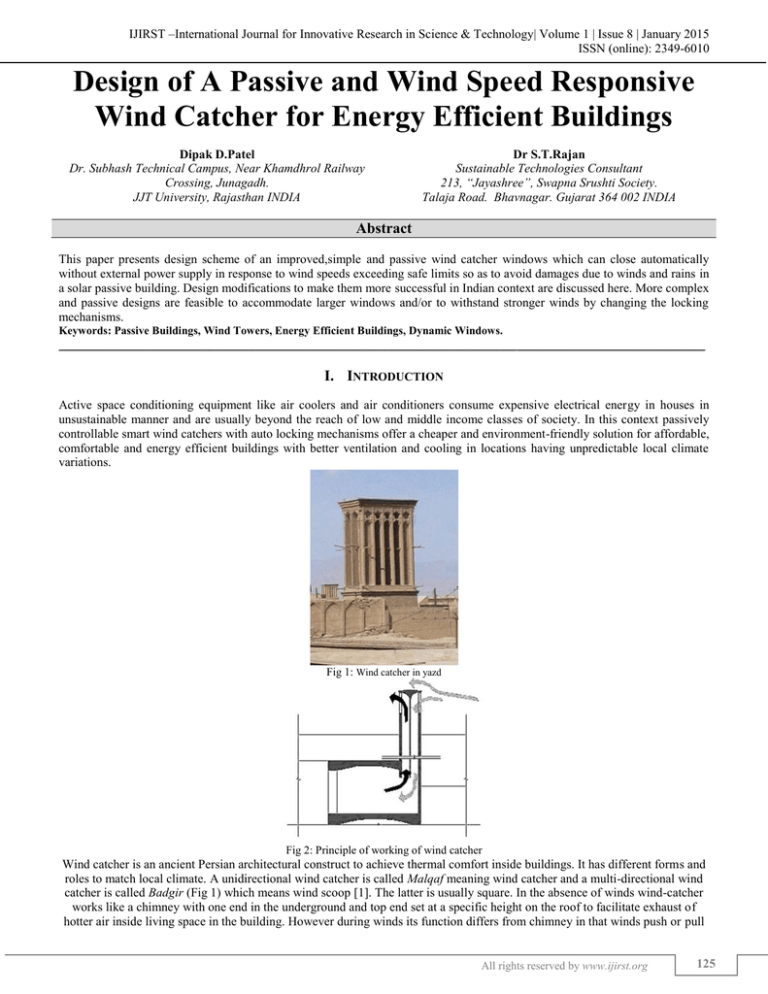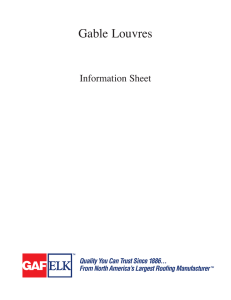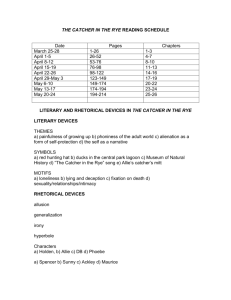
IJIRST –International Journal for Innovative Research in Science & Technology| Volume 1 | Issue 8 | January 2015
ISSN (online): 2349-6010
Design of A Passive and Wind Speed Responsive
Wind Catcher for Energy Efficient Buildings
Dipak D.Patel
Dr. Subhash Technical Campus, Near Khamdhrol Railway
Crossing, Junagadh.
JJT University, Rajasthan INDIA
Dr S.T.Rajan
Sustainable Technologies Consultant
213, “Jayashree”, Swapna Srushti Society.
Talaja Road. Bhavnagar. Gujarat 364 002 INDIA
Abstract
This paper presents design scheme of an improved,simple and passive wind catcher windows which can close automatically
without external power supply in response to wind speeds exceeding safe limits so as to avoid damages due to winds and rains in
a solar passive building. Design modifications to make them more successful in Indian context are discussed here. More complex
and passive designs are feasible to accommodate larger windows and/or to withstand stronger winds by changing the locking
mechanisms.
Keywords: Passive Buildings, Wind Towers, Energy Efficient Buildings, Dynamic Windows.
_______________________________________________________________________________________________________
I. INTRODUCTION
Active space conditioning equipment like air coolers and air conditioners consume expensive electrical energy in houses in
unsustainable manner and are usually beyond the reach of low and middle income classes of society. In this context passively
controllable smart wind catchers with auto locking mechanisms offer a cheaper and environment-friendly solution for affordable,
comfortable and energy efficient buildings with better ventilation and cooling in locations having unpredictable local climate
variations.
Fig 1: Wind catcher in yazd
Fig 2: Principle of working of wind catcher
Wind catcher is an ancient Persian architectural construct to achieve thermal comfort inside buildings. It has different forms and
roles to match local climate. A unidirectional wind catcher is called Malqaf meaning wind catcher and a multi-directional wind
catcher is called Badgir (Fig 1) which means wind scoop [1]. The latter is usually square. In the absence of winds wind-catcher
works like a chimney with one end in the underground and top end set at a specific height on the roof to facilitate exhaust of
hotter air inside living space in the building. However during winds its function differs from chimney in that winds push or pull
All rights reserved by www.ijirst.org
125
Design of A Passive and Wind Speed Responsive Wind Catcher for Energy Efficient Buildings
(IJIRST/ Volume 1 / Issue 8 / 021)
inside air out. Structurally also wind catcher is different from chimneys since it has openings on its sides instead of at the top and
also has a partition in the middle so that whichever way the wind may blow the upstream fluid pressure helps in better exhaust
of hotter interior air towards the downstream side (Fig2 ). Additionally if the wind catcher has underground water reservoirs or
ponds with an optional fountain built inside the house and near the entrance of the house then the wind passing over the water
gets cooled and humidified. With high swings in ambient temperature as in dry desert regions, the mud brick construction of
wind catcher gets cooler at night due to radiative cooling facilitated by clear night sky. This “storage of cold” in the construction
material helps in providing cooler air flow during day time due to winds [2]
II. TECHNOLOGICAL HURDLES IN WIDER ADAPTATION OF WIND CATCHERS
Though wind catchers are desirable architectural devices their implementation is not very popular in India and its neighborhood.
However CII-Sohrabji Godrej Green Business Centre (GBC) in Hyderabad in India inaugurated in July 2004 was a good modern
attempt to adapt the traditional design of wind catchers in India [3]. At that time it was claimed to be the first building in the
world outside the US to be awarded the 'platinum rating' under the LEED rating system, making it “the greenest building” in the
world. The GBC was built on an area of 5 acres near HITEC City in Hyderabad to serve as a demonstration building, as well as
an R & D center.
Fig 3: Wind catcher closed in the unoccupied house
of Dr S.T.Rajan in Bhavnagar, Gujarat
One main reason for unpopularity of wind catchers in India and its neighborhood is problems associated with extreme and
unpredictable weather changes varying in frequency of occurrences and in their intensities. For example during 1891-2006
periods coastal districts of Gujarat state in the western India experienced 28 tropical cyclones and coastal districts of Odisha state
in the Eastern India 98 [4]. A totally passive wind catcher puts its unoccupied or unattended parent building under two risks (i)
relating to gusts and storms which may cause mechanical damage and blow dust into interiors (ii) relating to rain which may be
carried by heavy winds inside the buildings. For example, consider the case of Gujarat in India. Geographically it is near to Iran.
However the state has the longest coastline in India totaling to about 1600 km. It has a wide ranging geological and climatic
conditions varying from rain and rivers fed fertile South Gujarat to arid Kutch region in the Western part. The Kathiawad
(Saurashtra) peninsula projecting into Arabian sea is dotted with small hill ranges led by Girnar hills in Junagadh-the tallest in
Gujarat state- whereas the adjoining Kutch region is very much plain. The structural remedies for the previously cited risks call
for shutters for the wind catcher unlike traditional designs of wind catchers. Further, operational remedies call for either (i)
manually closing the shutters of wind catcher by occupants forewarned about extreme weather conditions or prior to leaving the
building unoccupied or (ii) providing a wind responsive shutting arrangement either electrically driven by sensor-actuator or a
passively driven self sensing and actuating mechanism. The risks of blind copying of traditional Badgir design and consequent
weather related damages were realized by one of the authors of this paper after one stormy rain season when rain water was
flashed into the buildings through the wind tower and the openings of wind towers needed to be closed semi-permanently in his
new house built in 2009 in Bhavnagar, Gujarat, India (Fig 3) awaiting required structural and operational modifications.
III. WIND CATCHER DESIGN ASPECTS
The first modification required as per proposed design scheme of auto responsive wind catcher is to prevent winds and rains
blowing through the openings between the window frame and ends of louvers on both sides by setting the louvered window
inside a rectangular hood (Fig 4). In this way winds from sides can be blocked and winds are directed to blow approximately in a
direction perpendicular to louvers. Higher the depth of the hood more will be the perpendicularity of wind striking the windows.
Wind pressure on louvers which depend on wind speed, initial angle of inclination of louvers, size of louvers, and spacing
between the louvers can be more easily estimated and regulated when wind direction is perpendicular to louvers.
The second modification needed is to make the louvers close when wind speed exceeds preset limits. Two possible design
schemes are presented below.
All rights reserved by www.ijirst.org
126
Design of A Passive and Wind Speed Responsive Wind Catcher for Energy Efficient Buildings
(IJIRST/ Volume 1 / Issue 8 / 021)
Fig. 4: Modified Wind Catcher Design
A. Scheme 1
If wind speeds are fairly steady during hot season and if most of the time the house is occupied so that occupants can attend to
opening of windows that were locked automatically during adverse weather, then a locking mechanism of door foot stopper (Fig
5) can be considered which auto shuts louvers until manually released.
Fig. 5: Door foot stopper
B. Scheme 2
If winds blow with large daily or seasonal speed variations, then shock absorbers as used in motor cycles or gas springs as used
in kitchen shelves (Fig 6) can be attached to the top most or bottom most louver which is connected to the rest of the louvers
with a connecting rod . In this case there would be no locking mechanism but only auto closing of louvers proportional to
increasing wind speeds and auto opening proportional to decreasing wind speeds.
Fig. 6: Gas spring fitted louver (only the top louver shown)
IV. DESCRIPTION OF MODIFIED WIND TOWER
A proposed modification of wind tower is shown in Fig 4. The wind tower has openings on all four sides as in Badgir but the
windows are set a little deep inside a hood. All four openings have louvers hinged or pivoted on cross bars. All louvers of a
All rights reserved by www.ijirst.org
127
Design of A Passive and Wind Speed Responsive Wind Catcher for Energy Efficient Buildings
(IJIRST/ Volume 1 / Issue 8 / 021)
window are connected by a vertical connector rod which when moved uniformly swings all louvers by the same angle to open or
close the window as in a venetian blind.
If first scheme is preferred then two push type door stoppers are attached to the topmost louver and the side walls in such a
way the louvers will normally be inclined downward by a small angle (say 15 o). If the wind speed increases beyond a predetermined value, the louvers will be pushed down to the extreme position and the stoppers would lock which then have to be
released manually after the winds subside.
If second scheme is chosen then gas springs may be attached to the topmost louver and the side walls in such a way the
louvers will normally be inclined downward by a small angle (say 15 o). In this case the louvers will not be locked but will close
in proportion to wind speeds.
In both schemes a small frame to serve as window sill would be set on the outside of louvers but inside the hood to block any
rains getting through the windows.
The location specific design task would focus on matching of the lock components like their lengths, spring stiffness, the
overall dimensions of the windows, width to height to depth proportions and the materials to be used.
V. ANALYTICAL CONSIDERATIONS OF DESIGN SCHEME
(1) To provide an initial pushing down component of wind force, all louvers ought to be inclined at an appropriate angle,
otherwise if they are horizontal no perpendicular component force might be available.
(2) Once the wind starts pushing the louvers down, the perpendicular downward component of wind force will steadily increase
at constant wind speed until the louvers close.
(3) While setting the critical speed of winds at which the louvers ought to close, one should consider the lifting component of
the force of wind which strikes the louvers below and get deflected upwards and only the sum of net perpendicular forces
on all the louvers will act to close the louvers.
However because of the complexity of the dynamics of the winds accompanied by rains or not, will make a purely mathematical
solution nearly impractical and unrealistic. Hence the best course would be to fabricate a physical model and study its working in
a wind tunnel or in such similar set up.
VI. CONCLUSION
It is desirable that a passive and wind speed responsive control system be developed to close the windows of wind towers in
buildings meant for ventilation and space cooling. Two schemes of passive control of windows and related design issues are
presented here which can serve as the basis for their physical embodiment. Such control systems when produced and integrated
into wind towers can enable their applications over wider geographical regions exposed to storms and rains and much beyond the
traditionally dry locations in and near Iran. Such designs can also make passively controlled shelters more affordable and more
sustainable independent of external power supplies.
The comfort levels achieved in living space may not be as high as that may be achieved using desert coolers or airconditioners yet the wind towers can provide more tolerable living space conditions throughout a well designed home with
substantial savings in capital and running costs of space conditioning.
REFERENCES
[1]
[2]
[3]
[4]
Abdel-moniem El-Shorbagy (2010) Design with Nature: Windcatcher as a Paradigm of Natural Ventilation Device in Buildings, International Journal of
Civil & Environmental Engineering IJCEE-IJENS Vol:10 No:03, pp 21-26
A. A'zami (2005), Badgir in traditional Iranian architecture, International Conference “Passive and Low Energy Cooling for the Built Environment”, May
2005, Santorini, Greece
http://www.solaripedia.com/13/94/814/godrej_green_business_center_wind_tower_(india).html (accessed on 2nd Dec 2014)
Cyclones and their impact in India http://ncrmp.gov.in site of National Cyclone Risk Mitigation Project. (accessed on 3rd Dec 2014)
All rights reserved by www.ijirst.org
128



